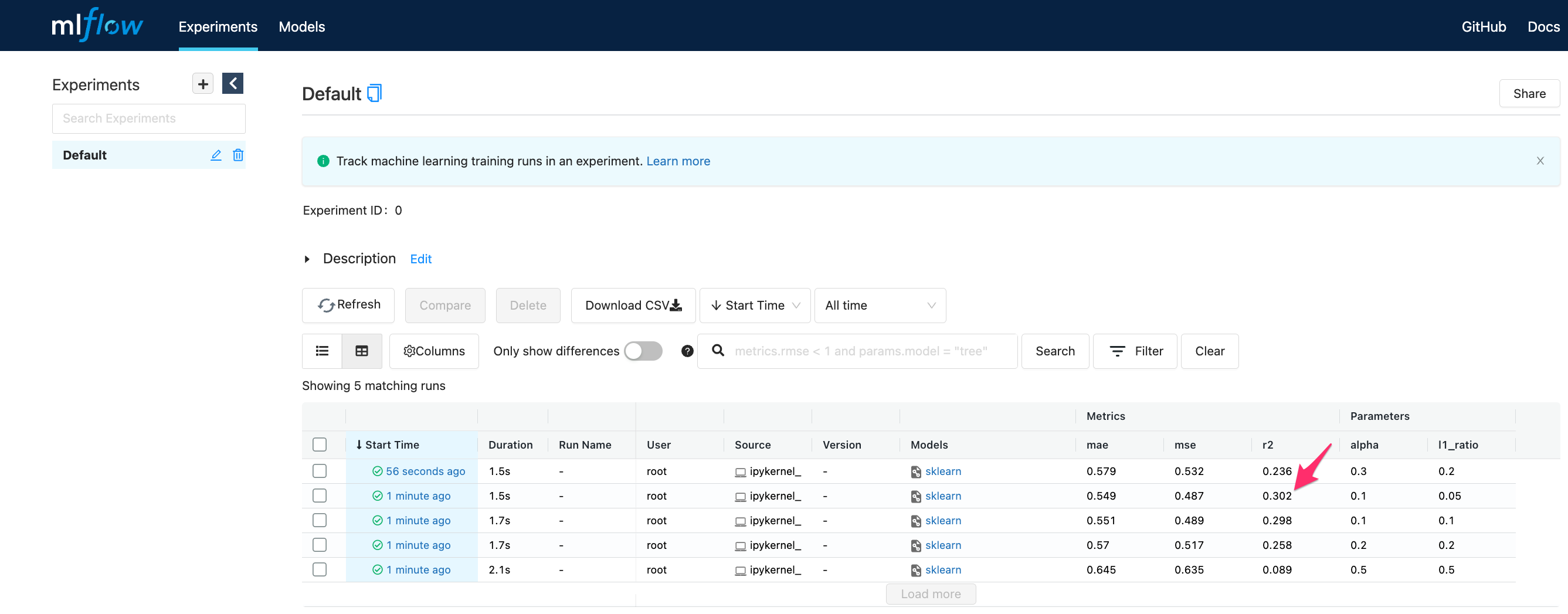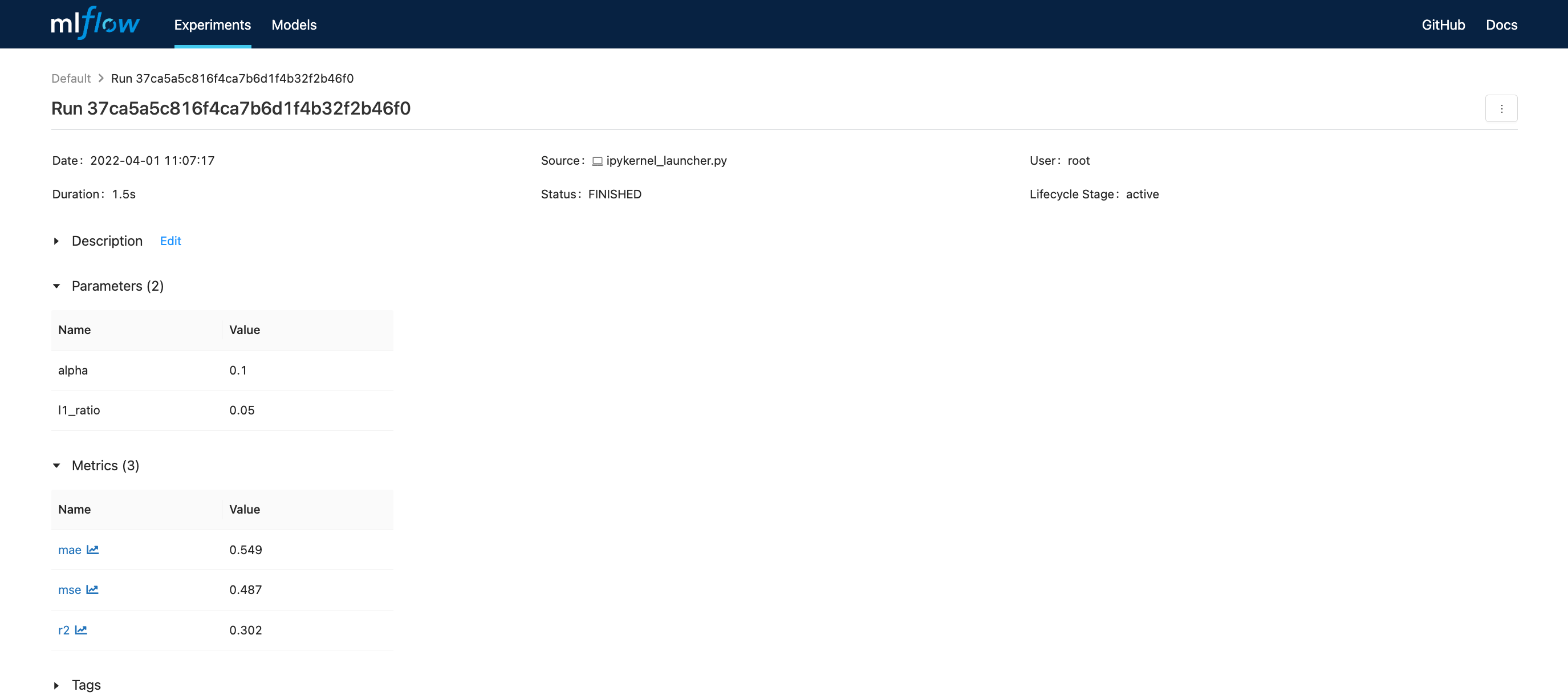Entrenamiento ingenuo de modelos en sklearn con MLflow#
Ultima modificación: Mayo 14, 2022
https://www.mlflow.org/docs/latest/quickstart.html
Carga de datos#
[1]:
def load_data():
import pandas as pd
url = "http://archive.ics.uci.edu/ml/machine-learning-databases/wine-quality/winequality-red.csv"
df = pd.read_csv(url, sep=";")
y = df["quality"]
x = df.copy()
x.pop("quality")
return x, y
Particionamiento de los datos#
[2]:
def make_train_test_split(x, y):
from sklearn.model_selection import train_test_split
(x_train, x_test, y_train, y_test) = train_test_split(
x,
y,
test_size=0.25,
random_state=123456,
)
return x_train, x_test, y_train, y_test
Cálculo de métricas de evaluación#
[3]:
def eval_metrics(y_true, y_pred):
from sklearn.metrics import mean_absolute_error, mean_squared_error, r2_score
mse = mean_squared_error(y_true, y_pred)
mae = mean_absolute_error(y_true, y_pred)
r2 = r2_score(y_true, y_pred)
return mse, mae, r2
Reporte de métricas de evaluación#
[4]:
def report(estimator, mse, mae, r2):
print(estimator, ":", sep="")
print(f" MSE: {mse}")
print(f" MAE: {mae}")
print(f" R2: {r2}")
Almacenamiento del modelo#
[5]:
# -----------------------------------------------------------------------------
# Ya no se requiere con MLflow
# -----------------------------------------------------------------------------
#
# def save_best_estimator(# estimator):
#
# import os
# import pickle
#
# if not os.path.exists("models"):
# os.makedirs("models")
# with open("models/estimator.pickle", "wb") as file:
# pickle.dump(estimator, file)
#
Carga del modelo#
[6]:
# -----------------------------------------------------------------------------
# Ya no se requiere con MLflow
# -----------------------------------------------------------------------------
#
# def load_best_estimator():
#
# import os
# import pickle
#
# if not os.path.exists("models"):
# return None
# with open("models/estimator.pickle", "rb") as file:
# estimator = pickle.load(file)
#
# return estimator
#
Entrenamiento#
[7]:
def train_estimator(alpha=0.5, l1_ratio=0.5, verbose=1):
import mlflow.sklearn
from sklearn.linear_model import ElasticNet
import mlflow
x, y = load_data()
x_train, x_test, y_train, y_test = make_train_test_split(x, y)
print('Tracking directory:', mlflow.get_tracking_uri())
with mlflow.start_run():
estimator = ElasticNet(alpha=alpha, l1_ratio=l1_ratio, random_state=12345)
estimator.fit(x_train, y_train)
mse, mae, r2 = eval_metrics(y_test, y_pred=estimator.predict(x_test))
if verbose > 0:
report(estimator, mse, mae, r2)
#
# Tracking de parámetros
#
mlflow.log_param("alpha", alpha)
mlflow.log_param("l1_ratio", l1_ratio)
#
# Tracking de metricas
#
mlflow.log_metric("mse", mse)
mlflow.log_metric("mae", mae)
mlflow.log_metric("r2", r2)
#
# Tracking del modelo
#
mlflow.sklearn.log_model(estimator, "model")
# -------------------------------------------------------------------------
# Ya no se requiere con MLflow
# -------------------------------------------------------------------------
#
# best_estimator = load_best_estimator()
# if best_estimator is None or estimator.score(x_test, y_test) > best_estimator.score(
# x_test, y_test
# ):
# best_estimator = estimator
#
# save_best_estimator(best_estimator)
Búsqueda manual de los mejores hiperparámetros#
[8]:
train_estimator(0.5, 0.5)
Tracking directory: file:///workspace/mlflow/mlruns
ElasticNet(alpha=0.5, random_state=12345):
MSE: 0.6349429447805036
MAE: 0.6453803508338732
R2: 0.0890018368226928
[9]:
train_estimator(0.2, 0.2)
Tracking directory: file:///workspace/mlflow/mlruns
ElasticNet(alpha=0.2, l1_ratio=0.2, random_state=12345):
MSE: 0.5170837474931838
MAE: 0.5701436798648394
R2: 0.2581028767270219
[10]:
train_estimator(0.1, 0.1)
Tracking directory: file:///workspace/mlflow/mlruns
ElasticNet(alpha=0.1, l1_ratio=0.1, random_state=12345):
MSE: 0.489021012335199
MAE: 0.551252749110561
R2: 0.29836649473051535
[11]:
train_estimator(0.1, 0.05)
Tracking directory: file:///workspace/mlflow/mlruns
ElasticNet(alpha=0.1, l1_ratio=0.05, random_state=12345):
MSE: 0.48683363717622585
MAE: 0.5493759222336462
R2: 0.30150487868829456
[12]:
train_estimator(0.3, 0.2)
Tracking directory: file:///workspace/mlflow/mlruns
ElasticNet(alpha=0.3, l1_ratio=0.2, random_state=12345):
MSE: 0.5322180010211477
MAE: 0.5793993870194708
R2: 0.23638867818623654
Comparación entre modelos usando MLflow#
Para visualizar la interfase use:
mlflow ui
Nota: En docker usar:
mlflow ui --host 0.0.0.0
con:

Hacer doble click en el modelo (Columna ‘Start Time’)



Chequeo#
[ ]:
def check_estimator():
import mlflow
x, y = load_data()
x_train, x_test, y_train, y_test = make_train_test_split(x, y)
# NOTA: este parámetro es copiado directamente de la interfase de MLflow
estimator_path = "runs:/37ca5a5c816f4ca7b6d1f4b32f2b46f0/model"
estimator = mlflow.pyfunc.load_model(estimator_path)
mse, mae, r2 = eval_metrics(y_test, y_pred=estimator.predict(x_test))
report(estimator, mse, mae, r2)
#
# Debe coincidir con el mejor modelo encontrado en la celdas anteriores
#
check_estimator(estimator_path=os.listdir('mlruns/0/')[0])
[14]:
%%bash
rm -rf outputs mlruns models